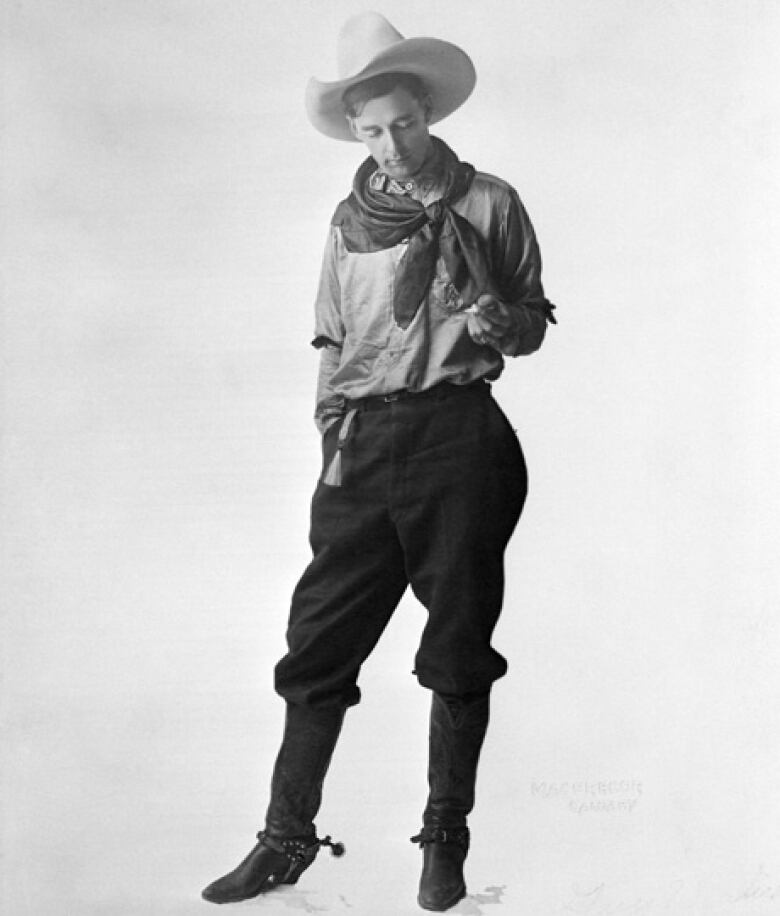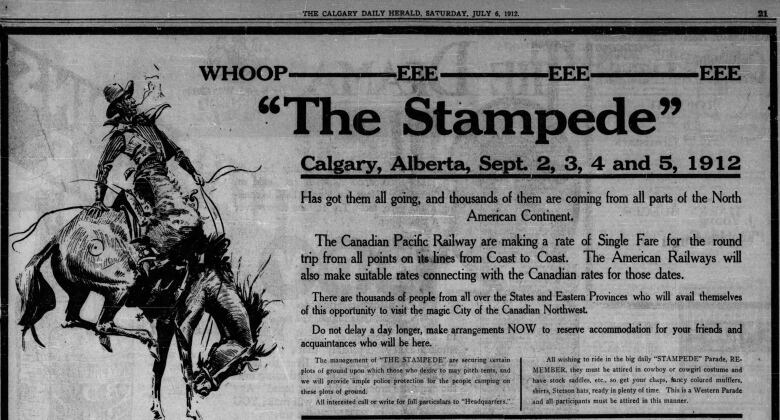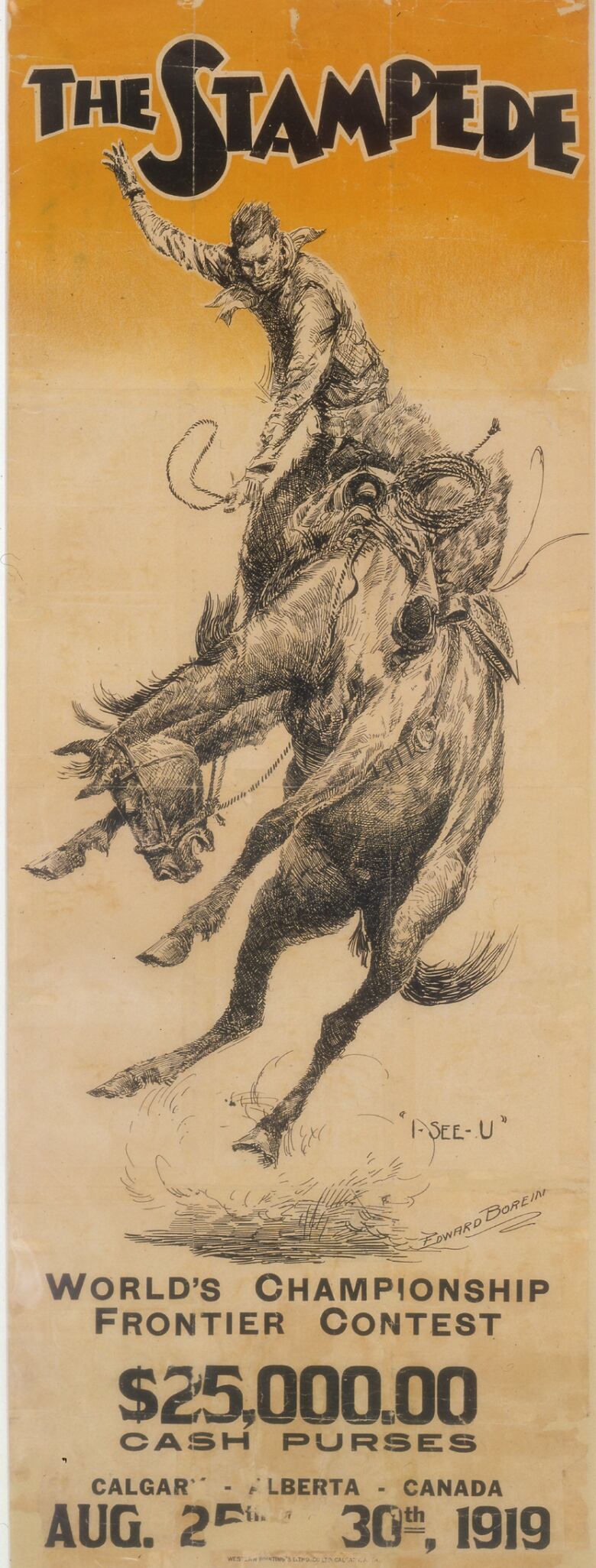5 things only the diehards know about Calgary's first Stampede
It included a pickpocket warning, royal guests and a Stampede shout you've probably never heard
Your friends think you're a Stampede geek.
You know all about this year's lineup at the Coca-Cola Stage. You've memorized the strange menu of midway foods. You can even name last year's winner at the chucks.
Congratulations. Impressive.
But just how well do you know the first Stampede?
CBCCalgary went deep into old newspaper reports from the time and dusted off a few history books to dig out some long-forgotten details.
Now check out five things only diehards know about the city's first Stampede.
1. Founderwas an American vaudeville performer
It's hard to imagine a place less like cowboy country than, say, Rochester, N.Y.
In 1885,it was a bustling urban centre in the eastern United States, while Calgary got the railroad just two years earlier. But that was the year and birthplace of Stampede founderGuy Weadick. A peculiar localefor such a prairie origin story to begin.
But here's the thing. Cowboys or rather, cowboys in pop culturewere big.
Even in Rochester.
The Old West was fading, but the tales and myths hadn't.Publishers pumped out cowboy comics and open-range stories like Disney does today with Star Wars spinoffs. Their songs endured. Crowds were enthralled byWild West shows. And,in Weadick'scase, California relatives had their ownfrontier stories to share with the impressionable lad.
And so, the gangly teenager decided to see it for himself.

Weadick headed west to the Great Plains and found ranch work.
He soaked up the stories, humour and some genuine skills. No one would mistake him for Wyatt Earp or even Buffalo Bill but Weadick parlayed his talents and matinee-idol looks into work doing rope tricks on the vaudeville circuit.
Along the way, the garrulous performer honed his skills as a promoter, and arrived in Calgary with some experience under his saddle, a dream in his heart.
2. Weadick's Stampede pitch was initially rejected
When Weadick came to Calgary in the winter of 1911-12, he was packing a mighty idea for the city's populace: a huge frontier pageant.
He wanted to put on an international rodeo featuring the best of the best!Huge cash prizes!!Crowds from far and wide!!!Cowboys and horses and roping and steers and all the glories of the Old West on display!!!!
It would be hugea real boost for the community'sprofile. Weadick, who had worked inthe city before, thought it was anideal spot for such an event.
But the response from the localbusiness community was "discouraging," noted Weadick chronicler Donna Livingstone in her book, The Cowboy Spirit.Management at the influential Calgary Industrial Exhibition also balked at the idea.
Money was likely one factor for the cool reaction, but it could've been the pitch itself.
"Most [of the business community] thought the idea was simply too big for Calgary," Livingstone wrote. "Besides, the day of the cowboy was over, they said. Alberta was looking ahead."
Calgary was the home of Alberta's first major public library. There was talk of a subway. Fairslike the 1908 Dominion Exhibition in the citywere fashionable. It reportedly drew 100,000 people with the latest in industrial advances, including Strobel's famous airship.
Airships. Not roping tricks. #Progress.
A hugerodeo? Pfft.
But then, word of the plan got to a handful of rich, influential ranchers who liked the idea of a last hurrah for the region's pioneer age. A way for an era to ride into the sunset.
So, the Big Four as they'd become known Patrick Burns, George Lane, A. E. Cross and Archibald J. McLean kicked in $25,000 each.

They challenged Weadick to stir up the excitement.
Yahoo!
3. A cheer that wasn't 'Yahoo!'
With the support of the Big Four and a September date in mind, Weadick began a publicity blitz.
Newspaper ads for the upcoming rodeo were big and plentiful. And, of course, every big event needs a signature cheer.
These days, some argue about whether to shout "Yahoo" or "Yeehaw" during the Stampede. It's obviously "Yahoo!" Right?

However, an early promotion for the inaugural Stampede in 1912 featured a very different cowboy yelp.
The big ad in the edition of the Calgary Daily Herald on July 6 trumpeted the big event with a "Whoop-eee-eee-eee." For real.
How exactly do you pronounce it? Did people actually shout it? All mysteries.
But whatever sound they were supposed to make, people flocked in for the event.

On Sept. 2, Weadick's marketing campaign drew an estimated 25,000 out-of-town guests to the city, reported The Albertan newspaper. For a little context, estimates put Calgary's population somewhere between 45,000 and 60,000 at the time.
While the first Stampede drew in ranchers and farmers and folks who wanted to see real rodeo, it also drew in a certain criminal element.
"Visitors to Calgary are warned that the city is full of pickpockets and holdup men, who have come here for the rich pickings that go with a crowd like the one that is swelling Calgary's population," a newspaper reported.
But along with the criminal class, the upper class also showed up.
4. Royalty attended, but reviews were mixed
Among the throngs to arrive in Calgary during the week were the Duke and Duchess of Connaught and their daughter, Princess Patricia.
The duke, who was the seventh child of Queen Victoria, was also governor general of Canada at the time. He was kind of a big deal.
"Calgary is the host and hostess to a prince of the royal blood, and to members of his distinguished family," the Herald enthused. "[They] are now at Victoria Park drinking in all of the wonders of a real wild-west show the stampede."
Sodrinking of some sort goes waaaaay back during Stampede time.
A good time was had with lots of events, and when the dust settled, there was a lot of praise, especially for the Big Four. Money well spent, apparently.

The contestants themselves women and men were also celebrated. There was huge praise for the performance of Tom Three Persons, a Blood Tribe member who stunned rivals in capturing the bronc riding title.
But it wasn't all Stampede love in the local press.
The Albertan complained that organizers (but not the Big Four) failed to promote the event stateside. Bit of irony with the promoter being American and all. The Herald also chastised management (but not the Big Four) for "its demeanor towards the public."
It said spectators should have been treated better for the prices charged. One might say grumblingabout prices was an early tradition. But the Stampedeitself wasn't about establishing any sort oftradition. Not yet, anyway.
5. It was goingto be one and done
Despite some grumping, the general sentiment around town was that the Stampede was a big success.

Merchants did a roaring business, chatting up the need for an annual event. The Albertan wrote a front-page editorial calling for as much.
But hold your horses, partner. This wasn't guaranteed back in 1912.
"The city was appreciative but not yet ready to make the stampede an annual event," Livingstone wrote inher book.
Big events cost big money.
The well-heeled ranchers who bankrolled the show were ready to move on, according to the journalist Fred Kennedy, who wrote The Calgary Stampede Storyin 1952.
"The 'Big Four' had kept their promise," he added. But, "they had financed the first show and now were ready to get back to their normal way of life."
Weadick and his wife, famed fancy roper Florence LaDue, hit the trail, taking versions of his Stampede extravaganza to Winnipeg and New York.
But then came one of those turning points in time.
With the end of the First World War, Calgary reached out to Weadick, asking him to hitch on back to town and put on a Victory Stampede for 1919.
This second rodeo was considered a success.
Whoop-eee-eee-eee!
The Stampede became an annual eventa few years later, in 1923, eventually morphing into the familiar Calgary Exhibition and Stampede.
The arrival of the mini donut took a few more decades.













_(720p).jpg)


 OFFICIAL HD MUSIC VIDEO.jpg)
.jpg)



























































































